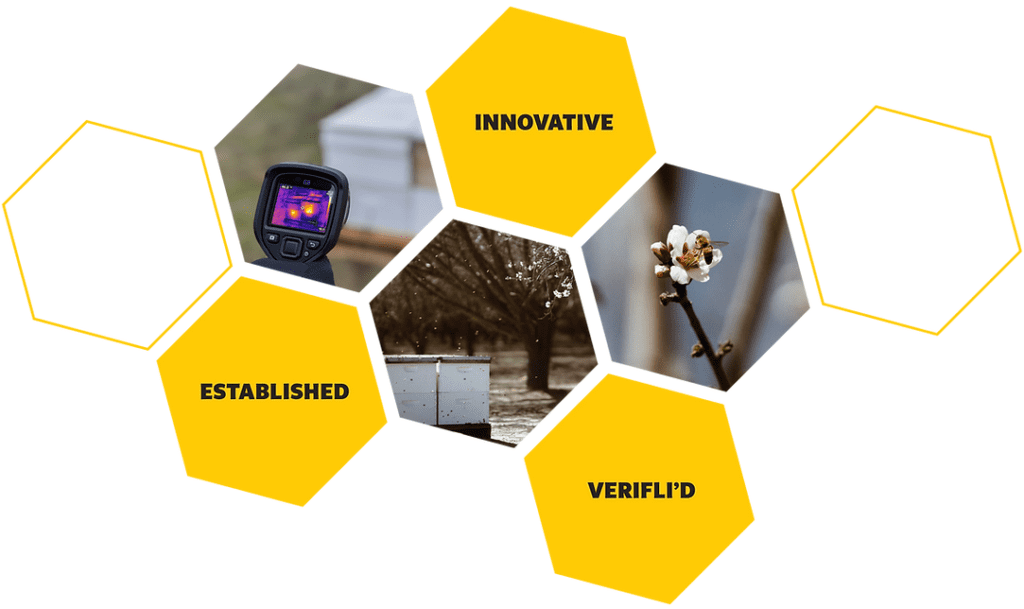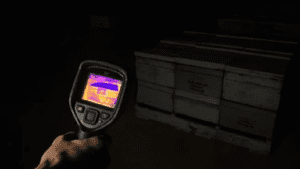
Mar 3, 2023Digital hive inspection service helps pollination
As with other input costs, growers need to limit expenses from skyrocketing pollination demand. More efficiently inspecting and monitoring honeybees can help growers and beekeepers restrain costs.
Bee Corp., Indianapolis, uses infrared imaging – which displays thermal energy – to assess a colony’s health. Its Verifli digital hive grading system uses photos to help growers enhance pollination quality while allowing beekeepers to increase pollination revenue per hive.

Bee Corp. personnel enter fields and orchards at night, when infrared is most accurate, and via an app and FLIR E8 (forward-looking infrared) camera, photograph individual beehives. The images are processed and allow growers to view hive frame strength results on their apps.
The process displays bee cluster heat signatures and can show growers and beekeepers how many frames of bees reside in the hives.
By providing a more objective and non-invasive look inside hives, growers can make better pollination decisions, said Ellie Symes, Bee Corp.’s CEO and co-founder. Inspections help ensure the hives placed on their property have enough bees to adequately pollinate the crops, she said.
Pollination patrol
With increasing demand and higher prices for pollination services, growers want to make sure they’re getting what they pay for in hive contracts, Symes said. Overworking hives is not healthy for the insect community and can lower pollination rates.
Digital inspections can provide more consistent results over manual inspections because opening hives disrupts the pollination process and hive tools foster the spread of diseases and pests, heightening hive injury, she said. Non-invasive inspections help avoid mistakes, including injuring queens, which even experienced beekeepers can do.
Another issue is over-renting of hives. Growers, who in the past weren’t always comfortable with inspection results, often placed more hives on their properties than needed. Evaluating how many hives are actually needed can lower expenses. It could also help improve bee population imbalances and competition with native bees, Symes said.
“A great way to increase farm profitability and cut-down their costs is by figuring exactly what’s needed,” she said.
When growers end overrenting, they can deal with some of the population imbalances that the beekeeping industry has experienced, Symes said.
 An almond grower, for example, can spend $400 to $500 an acre on bees that work for about six to eight weeks, like any other growing expense, if something could measure hive quality, the grower could better manage pollination decisions, said Stuart Woolf, president and CEO of Woolf Farming, a Fresno, California, grower of conventional and organic almonds, pistachios, processing tomatoes and other crops, including grapes and onions. He said he was interested in the technology’s ability to determine hive quality.
An almond grower, for example, can spend $400 to $500 an acre on bees that work for about six to eight weeks, like any other growing expense, if something could measure hive quality, the grower could better manage pollination decisions, said Stuart Woolf, president and CEO of Woolf Farming, a Fresno, California, grower of conventional and organic almonds, pistachios, processing tomatoes and other crops, including grapes and onions. He said he was interested in the technology’s ability to determine hive quality.
Increased accuracy
Low-tech inspections involve growers randomly opening hives with a beekeeper, pulling out individual frames to determine bee quantities.
“This allows us to actually measure these things,” Woolf said. “Along with the beekeepers we deal with, they supply a number of different growers. The spectrum of health and quality and the number of frames in the hives, they do vary. I thought it would be a great tool to pay a beekeeper more to deliver higher quality. We as farmers would be better off getting better hives.”
When growers receive an unfavorable hive report, Bee Corp. grower-customers are better equipped to work with their beekeepers to solve issues because hives can decline quickly, Symes said.
“With Verifli, we want to make sure pollination transactions are smooth,” she said. “The grower is getting enough bees, first and foremost, while the beekeeper is paid properly.
“This helps the industry optimize pollination and makes pollination more sustainable,” Symes said. “Where this helps the industry beyond what is available now is that we have a tool that can be relied on and is more accurate.”
Varied crop application
There are 90 U.S. crops pollinated by bees, but Bee Corp is concentrated on blackberries, blueberries, raspberries, almonds, avocados, kiwi fruit and oil seeds. The company is talking with growers of other crops, including apples, and expanding crop offerings, Symes said.
Over-pollination adds to pruning costs, so apple growers are expressing strong interest in the Bee Corp. service because they don’t want their orchards to be over-pollinated, she said.
Bee competition is an issue because overpopulation pushes bees to compete for locations. When bees are required to feed more due to less forage available, it increases grower costs because beekeepers must spend more money on feed. With too many bees, there aren’t enough flowering foods available, which results in artificial feedings. The overpopulation also pushes out native species. The system aids with assessing hive stocking rates.
At Indiana University in 2016, Symes, who was studying environmental science, met Wyatt Wells, company co-founder and chief operating officer. The two founded the university’s beekeeping club. They first focused their technology on hobby beekeepers, but were encouraged by university alumni who saw the commercial ag applications. The alums helped Symes and Wells win startup funding and business plan competitions.
In 2018, they won a National Science Foundation grant to expand the technology to the larger commercial arena. The grant required interviews of industry people. Conversations with growers and beekeepers about their difficulties in pollination showed how their service could help improve annual hive inspections.
— Doug Ohlemeier, assistant editor
Photos courtesy Bee Corp.
















